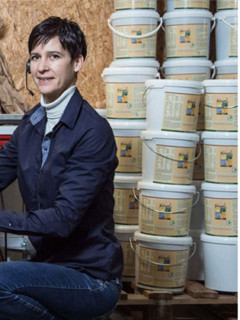Everyone believes in something different. Grandma swears by brandy – applied both internally and externally. Last – and surprisingly often effective – advice from a colleague in IT: the new start. And since Michael Constantine played the Greek father-in-law in My Big Fat Greek Wedding, we know that glass cleaner helps against everything.
One for all: Gaffa keeps the world together
Here it is probably the famous faith that moves mountains. People often argue passionately about their own personal secret recipes. But there are also a few things that everyone agrees on. Tissue tape is one such “thing”. Everyone can tell at least one story where the extremely resistant all-rounder saved the day: fixing rain gutters, sealing holes in the garden hose, repairing the heel of a shoe, making a hockey stick “grippy”, making an original knight’s costume, gluing a torn rucksack strap. Fixing heavy pieces of luggage, gluing on the mudguard, building a boat that can float…
Fabric tape is simply perfect for fixing, repairing, sealing and bundling. It is extremely durable, moisture-resistant and adheres very well to dusty and rough surfaces such as masonry or wood.
Fabric tape defies heat, cold and water
This all-rounder is also virtually unaffected by all kinds of weather. When things get a little “hotter”, for example, the fabric tape from tesa does a great job. It can withstand temperatures of up to 95 °C. On the other hand, Advance fabric tape can withstand extreme cold of up to -50 °C if it has been processed at room temperature.
Very practical: despite these properties, the fabric tape can be easily torn by hand, so you really don’t need any other tools such as scissors or cutters.
Gaffa or Gaffer? Duck or Duct?
But is it actually called gaffa or gaffer? Or, as is argued in the English-speaking world: Duct Tape or Duck Tape? Here, too, fabric tape is extremely flexible. It “trades” under all these names (and a few more).
There is also disagreement about the origin of duct tape. Wikipedia has this version: Originally developed for the American military in classic camouflage green, fabric tape was intended to keep moisture away from ammunition boxes. Under the term Duck Tape (derived from the German word Tuch and the Dutch term doek), the fabric tape served faithfully, also as a makeshift for repairs to tanks, aircraft and rifles. An alternative explanation to the term duck tape lies in its excellent waterproofing properties. Since it allows water and dust to “roll off” like duck feathers, i.e. like a “duck”, it was given the name “duck tape”.
From the military into the home and onto the stage
The fabric tape had won over the entire male world by storm and was used often and with pleasure after the war during the boom phase of the building industry. Builders, craftsmen and caretakers resorted to the tape for all kinds of work, but especially for ductwork. Because of the word relationship, Duck Tape very quickly became Duct Tape. Visually, the tape also adapted to its new purpose: Instead of the military green, the silver, “pipe-coloured” version was now predominantly in demand.
Fabric tape was (and is!) also popular on theatre stages and television sets. To fix stage lighting and cables, for example, the tape also became known as gaffer (English for foreman, lighting technician, electrician, overhead lighting technician). In the vernacular, it then became gaffa. And again, the fabric tape “chameleonfix” adapted its colour: To attract as little attention as possible and reflect as little light as possible, the classic gaffa tape is offered in black.
The fabric tape – chameleon
Fabric tape has found its very own purpose in almost every industry – and changed colour as needed. In the meantime, the all-rounder is also offered for marking purposes in neon colours and for handicrafts in all colours of the rainbow – the internet is full of really creative ideas! In industry and handicrafts, in workshops and on construction sites and on theatre stages, however, the tape is mainly used in silver, black and occasionally white (inscribable).
Armoured tape = strong like a tank, respectively twisted together to a "rope" able to pull a tank
Lasso = the Austrian term
MacGyver tape = in English-speaking countries, due to its immensely versatile uses















